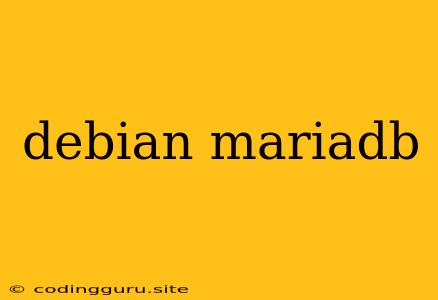Setting Up MariaDB on Debian: A Comprehensive Guide
Debian is a popular Linux distribution known for its stability and wide range of software packages, including databases. MariaDB, a powerful and reliable open-source relational database management system, is often the preferred choice for Debian users. In this guide, we'll walk you through the process of installing and configuring MariaDB on your Debian system, covering essential steps and best practices.
Why Choose MariaDB on Debian?
Before we dive into the installation process, let's understand why MariaDB is a great choice for your Debian environment:
- Open Source and Community Driven: MariaDB is an open-source database, meaning it's free to use and modify. It benefits from a vibrant and active community of developers, ensuring ongoing development and support.
- High Performance and Scalability: MariaDB is renowned for its performance and ability to scale efficiently, making it suitable for various applications, from small personal projects to large enterprise deployments.
- Compatibility with MySQL: MariaDB offers excellent compatibility with MySQL, allowing you to seamlessly migrate your existing MySQL databases or applications to MariaDB.
Installing MariaDB on Debian
Installing MariaDB on Debian is straightforward using the built-in package manager. Here's a step-by-step guide:
-
Update Your System:
sudo apt update -
Install MariaDB:
sudo apt install mariadb-server -
Start MariaDB Service:
sudo systemctl start mariadb -
Enable MariaDB Service on Boot:
sudo systemctl enable mariadb
Securing Your MariaDB Installation
After installing MariaDB, it's crucial to secure your database server. MariaDB provides a built-in security script to help you with this process.
-
Run the Security Script:
sudo mysql_secure_installation -
Follow the prompts: The script will guide you through steps like setting a root password, removing anonymous users, disabling remote root login, and removing test databases.
Accessing the MariaDB Shell
Once MariaDB is installed and secured, you can access its command-line interface (shell) to manage your database.
-
Log in as root:
mysql -u root -p -
Enter the password you set during the security script.
Creating a New User and Database
Let's create a new user and a database for your application.
-
Create a new user:
CREATE USER 'your_user'@'localhost' IDENTIFIED BY 'your_password'; -
Grant permissions to the user:
GRANT ALL PRIVILEGES ON your_database.* TO 'your_user'@'localhost'; -
Create the database:
CREATE DATABASE your_database; -
Flush privileges:
FLUSH PRIVILEGES;
Connecting to MariaDB from Applications
Now that you have a secure MariaDB installation and a dedicated user and database, you can connect to it from your applications using various tools and libraries:
- Using the
mysqlcommand: You can use themysqlcommand-line tool to connect to your database and execute queries. - Database Libraries: Many programming languages offer dedicated libraries for connecting to and interacting with MariaDB, such as:
- Python:
mysql-connector-python - Node.js:
mysql - PHP:
mysqli
- Python:
Managing MariaDB
MariaDB offers a wide range of tools and utilities for managing your database effectively. Here are a few essential ones:
mysqlcommand-line tool: Use this tool for interacting with your database directly, running queries, creating tables, and managing users.mysqldump: Back up your database data and schema usingmysqldumpfor data protection and recovery.mysqlcheck: Verify the integrity of your database tables and perform consistency checks.mysqlbinlog: Analyze and debug your database replication logs.
Conclusion
Setting up MariaDB on Debian is a relatively straightforward process. By following the steps outlined in this guide, you can have a secure, reliable, and powerful database system running on your Debian server. Remember to secure your installation, create dedicated users and databases for your applications, and familiarize yourself with the available tools for managing your MariaDB environment. With MariaDB's robust features and open-source nature, you have a solid foundation for building and deploying your database-driven applications.
